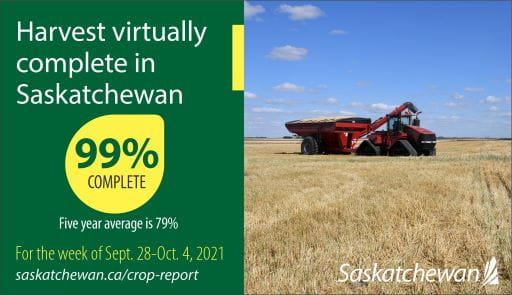Released on October 7, 2021
Harvest is practically complete in the province, with nearly all regions having 99 per cent of the crop in the bin. The five-year (2016-2020) average for harvest progress for this time of year is 79 per cent. Producers continue to do post-harvest work in the fields such as harrowing, weed control and preparing to or bringing livestock home. There have been reports that the dry soil conditions and recent cold temperatures have limited fertilizer and herbicide applications.
Harvest weather was favourable throughout the fall, allowing producers to harvest without major delays from rain or waiting for crops to mature. The season-long drought and extreme temperatures caused crop yields to be much lower than average; however, most crops were reported to be within the top two quality grades. Several small rain storms in early-September meant most of the province experienced regrowth in pastures and fields. This regrowth caused issues with harvest, especially in crops like canola. Producers had to apply herbicides or find other solutions in order to begin harvest.
Crop yields varied throughout the province, depending heavily on the amount of moisture received throughout the season. Overall provincial yields are well below average, even areas that received timely rains reported below average yields. Yields were impacted by the extreme drought, heat stress, wind, hail and grasshoppers. Average yields are estimated as 30 bushel per acre for hard red spring wheat, 19 bushel per acre for durum, 49 bushel per acre for oats, 34 bushel per acre for barley, 21 bushel per acre for canola, 22 bushel per acre for peas and 870 pounds per acre for lentils.

Moisture conditions remain a concern, with much of the province receiving minimal or below average rainfall this year along with hot temperatures and drying winds throughout the growing season. All regions in the province reported that their topsoil moisture was short or very short for most of the season.
Significant precipitation is needed this fall and winter to replenish moisture levels in the soil and dugouts. Heading into winter, topsoil moisture on cropland is rated as twelve per cent adequate, 43 per cent short and 45 per cent very short. Hay and pasture land topsoil moisture is rated as eight per cent adequate, 35 per cent short and 57 per cent very short.
Average hay yields on dry land are reported as 0.79 tons per acre (alfalfa), 0.77 tons per acre (alfalfa/brome and wild hay), 0.55 tons per acre (other tame hay) and 1.13 tons per acre (greenfeed). On irrigated land, the estimated average hay yields are 2.2 tons per acre (alfalfa), 2.1 tons per acre (alfalfa/brome), 1.60 tons per acre (wild hay) and 1.9 tons per acre (greenfeed). Most of the hay going into winter is rated as poor to good in quality.
At this time, most livestock producers indicated they will have inadequate to adequate supplies of hay, straw, greenfeed and feed grain heading into winter. Many areas in the province will have inadequate winter feed supplies and shortages are expected due to a poor first cut of hay and the inability to get a second cut. The late rains did allow for some pastures to briefly green up and extend grazing for one or tow more weeks.
Due to the dry conditions this year, dugout, slough and well levels have been low and there are concerns about livestock water supplies. Some producers were able to use crop residue and straw from their grain farming neighbours and use it as feed. The late rains allowed for some pastures to briefly green up and extend grazing for one or two more weeks.
With drier than normal field conditions this fall, the number of acres seeded to winter cereals is below normal. In most areas, winter wheat acres are estimated to fall 17 per cent, while fall rye is estimated to fall twelve per cent. With harvest wrapping up in most regions, there was adequate time for seeding but there were concerns with poor germination and establishment of winter cereals prior to winter due to the extremely low topsoil moisture conditions.
Producers were able to complete fall work such as fixing fences, moving cattle, hauling grain and bales, picking rocks, spraying weeds and working fields. Producers will continue to do this work until the temperature drops sharply or a big snowfall occurs.
Even as harvest winds-up in Saskatchewan, we want to remind producers to exercise caution and remain safe in their post-harvest operations.
A complete, printable version of the Crop Report is available online at https://www.saskatchewan.ca/crop-report.
Follow the 2021 Crop Report on Twitter at @SKAgriculture.
-30-
For more information, contact:
Matt Struthers
Agriculture
Moose Jaw
Phone: 306-694-3714
Email: matt.struthers@gov.sk.ca
Cell: 306-630-8865

